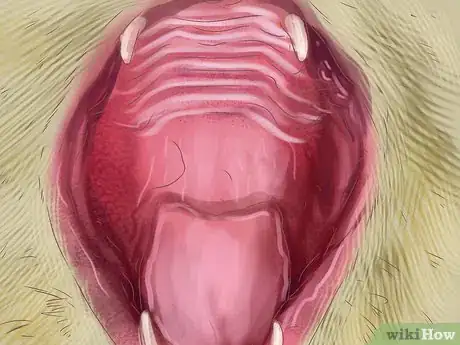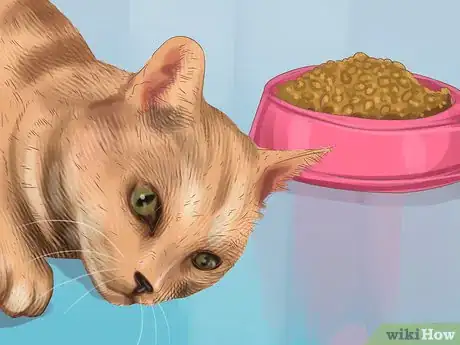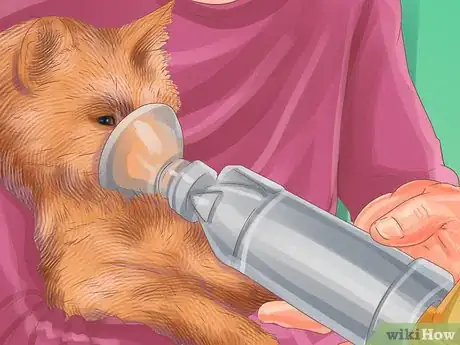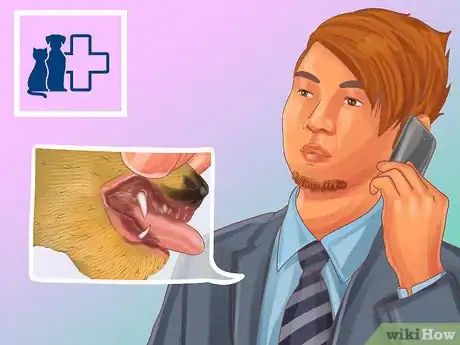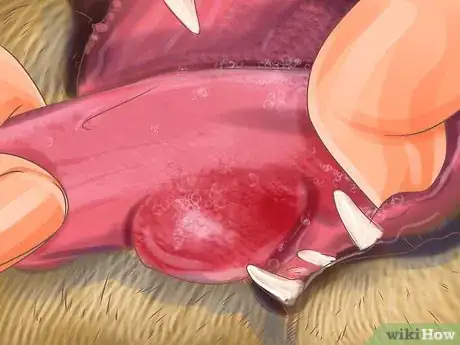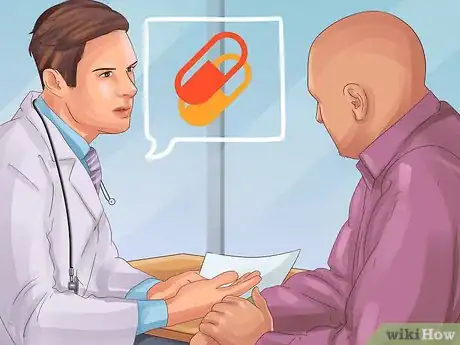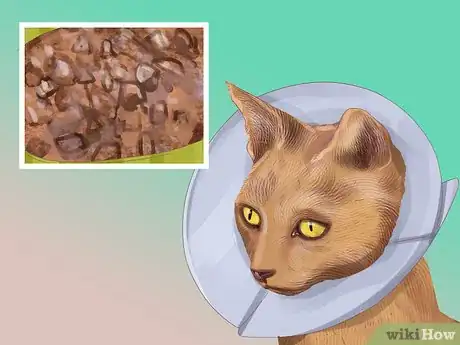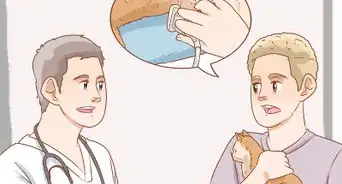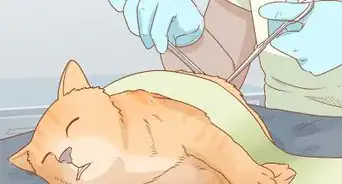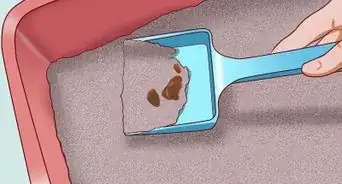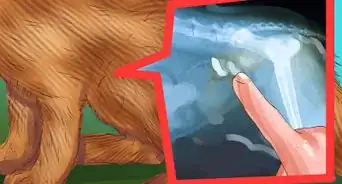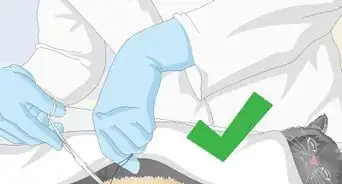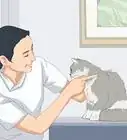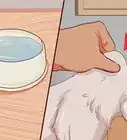This article was co-authored by Ryan Corrigan, LVT, VTS-EVN. Ryan Corrigan is a Licensed Veterinary Technician in California. She received her Bachelor of Science in Veterinary Technology from Purdue University in 2010. She is also a Member of the Academy of Equine Veterinary Nursing Technicians since 2011.
There are 8 references cited in this article, which can be found at the bottom of the page.
This article has been viewed 18,366 times.
Salivary gland complications in cats are uncommon, but mucoceles do occur in some cats.[1] Mucoceles, sometimes called salivary cysts, are generally painless masses of saliva built up in the salivary glands or subcutaneous tissue of a cat’s mouth and throat. While not typically harmful on their own, these masses can lead to swelling, bleeding and discharge in the mouth, trouble eating, and difficulty breathing. If you notice any swelling or symptoms associated with mucoceles in your cat, take them to the vet for diagnosis. Typically, a small surgery can fix the problem for the long-term.
Steps
Monitoring Symptoms at Home
-
1Examine the mouth area. Swelling in the salivary glands often causes swelling around the entirety of the face, as well as blood in saliva and soft masses in the neck. Check the face and neck area to look for symptoms of salivary mucoceles.[2]
- Use your finger to gently pull up on the cheeks and expose the teeth and gums. Visually check for swelling, bleeding, or discoloration. You may also want to smell for bad breath.
- Run the back of your hand down the cat’s neck, applying light pressure, to feel for masses.
-
2Watch their daily habits. Salivary cysts can cause lethargy, loss of appetite, difficulty eating, and other behavioral changes. Watch your cat’s daily habits to see if they are eating or drinking less, or avoiding playing and other physical activity they typically enjoy.[3]
- If your cat is typically lethargic, maybe due to age or a disability, do not assume lethargy alone is a symptom. Look for other symptoms, as well.
- Also watch your cat for vomiting. If they are eating well but throwing up regularly, it may be a sign that something is wrong.
Advertisement -
3Listen for respiratory distress. A salivary mucocele may cause respiratory distress such as difficulty breathing and difficulty swallowing. Listen for wheezing, labored breathing, or other signs that your cat may be struggling to properly intake air.[4]
- If your cat seems to be experiencing any respiratory distress, seek help from a vet immediately. Trouble breathing could cause brain damage or become fatal if not treated quickly.
Getting a Veterinary Diagnosis
-
1Make an appointment to look for mucoceles. Only a trained veterinarian should diagnose and treat salivary problems for your cat. If your cat is showing symptoms of salivary swelling, make an appointment with your vet and ask them to check for mucoceles.[5]
- Let your vet know what symptoms you have observed at home, and provide as much detail as you can about when you began noticing behavioral changes.
-
2Test for tumors and abscesses. A vet can readily distinguish between a mucocele and a more severe problem such as a tumor with some simple testing. If recommended by your vet, allow them to test the detected mass using a fine needle biopsy, as well as imaging tests like sialography.[6]
- These tests are often painless and not invasive for your cat, and they help your vet rule out more extreme problems such as cancers.
-
3Ask the vet about treatment options. Treatment options will be different depending upon your vet’s diagnosis after testing. Ask your vet, “what treatment options do you recommend for my cat’s particular problem?” Follow your vet’s recommendations as closely as you are able.[7]
- If your cat is experiencing a problem other than a salivary mucocele, they may require more intensive testing and treatment. Talk to your vet extensively about treatment options, their cost, and their overall success rates.
Treating Salivary Swelling
-
1Seek surgical removal. Minor surgery is generally the best treatment option for masses and cysts in the salivary glands. Talk to your vet about having the masses surgically removed, or otherwise tying off damaged ducts to help stop saliva leakage.[8]
- While draining the cysts is sometimes an option, they are likely to reoccur and/or become infected, so removing the glands is the best course of action.[9]
- Before you have the actual procedure performed, talk to your vet about any potential risks associated with the procedure. Let them know about any pre-existing conditions your cat may have, and see if they impact your cat’s eligibility for the removal procedure.
- Seek removal immediately if the masses are impacting your cat’s ability to eat or breathe.
-
2Allow time for recovery. After surgery, your cat will need time to rest and recover. Follow your vet’s instructions for aftercare, and carefully monitor the incision site for signs of infection such as swelling, redness, or discharge.[10]
- Your cat may need to be placed on soft foods until the incisions heal so that they do not aggravate the injuries.
- Your cat may also be placed on antibiotics to help prevent infection. Administer them regularly according to your vet’s instructions.
- Some antibiotics may decrease your cat’s appetite, so you will need to pay attention to any changes in your cat’s habits and let your vet know of any issues.
-
3Schedule follow-ups. After cyst removal, be sure to schedule regular follow-up appointments as suggested by your vet. The first appointment should be 2 weeks or so after the surgery to make sure the incision has healed and no infection is present.[11]
- If you think an infection may be present, don’t wait until your follow-up appointment. Contact your vet immediately to schedule a check-up.
- If you notice radical changes in your cat’s behavior or habits, bring them to the vet as soon as possible.
- If you move or find a new vet, let them know during your first appointment that your cat experienced salivary swelling in the past. This way, the new vet knows to monitor for any future complications.
Warnings
- Do not try to remove or drain a mucocele yourself. This may lead to injury or infection. Always seek professional veterinary help.⧼thumbs_response⧽
References
- ↑ https://www.ncbi.nlm.nih.gov/pubmed/1802253
- ↑ http://www.petmd.com/cat/conditions/mouth/c_ct_salivary_mucocele
- ↑ https://www.vetary.com/cat/condition/salivary-gland-swelling
- ↑ https://www.acvs.org/small-animal/salivary-mucocele
- ↑ http://www.merckvetmanual.com/digestive-system/diseases-of-the-mouth-in-small-animals/salivary-disorders-in-small-animals
- ↑ http://www.merckvetmanual.com/digestive-system/diseases-of-the-mouth-in-small-animals/salivary-disorders-in-small-animals
- ↑ http://www.petcancercenter.org/Cancer_Types_salivary_gland.html
- ↑ https://icatcare.org/advice/cat-health/oral-disease-cats
- ↑ https://www.dvm360.com/view/salivary-mucoceles-cats-retrospective-study-seven-cases
About This Article
If your cat has mucoceles, or salivary cysts, it may have swelling in its face, as well as blood in its saliva, and soft masses in its neck. Other symptoms to check for include swelling, bleeding, or discoloration in the mouth, bad breath, and trouble breathing or swallowing. However, only a trained veterinarian should diagnose and treat salivary problems for your cat, so take it to a vet immediately if you suspect it might have mucoceles. Your vet will most likely test for tumors and abscesses in the salivary glands, then surgically remove the masses. For more tips from our Veterinary co-author, including how to care for your cat after its surgery, read on.
